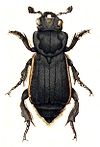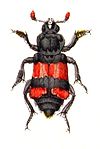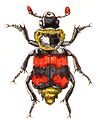- Burying beetle
-
Burying beetle 
Nicrophorus americanus, American burying beetle Scientific classification Kingdom: Animalia Phylum: Arthropoda Class: Insecta Order: Coleoptera Family: Silphidae Subfamily: Nicrophorinae Tribe: Nicrophorini Genus: Nicrophorus
Fabricius, 1775Type species Silpha vespillo
Linnaeus, 1758Burying beetles or sexton beetles (genus Nicrophorus) are the best-known members of the family Silphidae (carrion beetles). Burying beetles are true to their name. Most of these beetles are black with red markings on the elytra (forewings). They bury the carcasses of small vertebrates such as birds and rodents as a food source for their larvae. They are unusual among insects in that both the male and female parents take care of the brood.
The genus name is sometimes spelt Necrophorus in older texts. This is an emendation by Carl Peter Thunberg (1789) of Fabricius's original name, and is not valid.
Contents
Reproduction
Burying beetles have large club-like antennae equipped with chemoreceptors capable of detecting a dead animal from a long distance. After finding a carcass (most usually that of a small bird or a mouse), beetles fight amongst themselves (males fighting males, females fighting females) until the winning pair (usually the largest) remains. If a lone beetle finds a carcass, it can continue alone and await a partner. Single males attract mates by releasing a pheromone from the tip of their abdomens. Females can raise a brood alone, fertilizing her eggs using sperm stored from previous copulations.
The carcass must be buried by the beetle(s) to get it out of the way of potential competitors, which are numerous.
The prospective parents begin to dig a hole below the carcass. While doing so, the beetles cover the animal with antibacterial and antifungal oral and anal secretions, slowing the decay of the carcass and preventing the smell of rotting flesh from attracting competition. The carcass is formed into a ball and the fur or feathers stripped away and used to line and reinforce the crypt, where the carcass will remain until the flesh has been completely consumed. The burial process can take around 8 hours. Several pairs of beetles may cooperate to bury large carcasses and then raise their broods communally.
The female burying beetle lays eggs in the soil around the crypt. The larvae hatch after a few days and move into a pit in the carcass which the parents have created. Although the larvae are able to feed themselves, both parents also feed the larvae: they digest the flesh and regurgitate liquid food for the larvae to feed on, a form of progressive provisioning. This probably speeds up larval development. It is also thought the parent beetles can produce secretions from head glands that have anti-microbial activity, inhibiting the growth of bacteria and fungi on the vertebrate corpse. [1]
At an early stage, the parents may cull their young. This infanticide functions to match the number of larvae to the size of the carcass so that there is enough food to go around. If there are too many young, they will all be underfed and will develop less quickly, reducing their chances of surviving to adulthood. If there are too few young, the resulting adult beetles will be large but the parents could have produced more of them. The most successful beetle parents will achieve a good balance between the size of offspring and the number produced. This unusual method of brood size regulation might be the result of the eggs being laid before the female has been able to gauge the size of the carcass and hence how many larvae it can provision.
The adult beetles continue to protect the larvae, which take several days to mature. Many competitors make this task difficult, e.g. bluebottles and ants or burying beetles of either another or the same species. The final-stage larvae migrate into the soil and pupate, transforming from small white larvae to fully formed adult beetles.
Aside from eusocial species such as ants and honey bees, parental care is quite rare among insects, and burying beetles are remarkable exceptions.
COMMUNAL BREEDING N. tomentosus : 1-6 males, 1-7 females.It shows social behaviour and main characteristics are
Cooperative brood care
Overlapping generations Frequency of communal breeding Varies with species Ex : N. obicollis most of the times breed communally Varies with the carcass size. Females can enter into communal breeding more readily than males. Carcass size for communal breeding Affects the frequency of communal breeding, Multiple males and/or females of N.orbicollis found on 50-90 g carcass.Larger carcass - better the communal breeding. Reasons for communal breeding on large carcass Smaller carcass – can fully utilized by single female, larger one cannot Two females – can rear more larvae than one Larger carcass – difficult to exploit It takes longer time – to fully conceal and prepare the carcass for single pair To avoid competitors Communal breeding results in Bigger female – Provide longest care Relative duration of care – Positively correlated with success within the association Large carcass – Reproduction is divided between 2 females equally or at least randomly Small carcass – Reproduction usually skewed in favor of bigger females Bigger females of species that breed communally – Dominant and more Fecund Females increase the proportion of their young in brood through differential destruction of their competitors eggs On counter part the females of species that readily breed communally lay eggs randomly in the soil which make difficult to locate and destroy
Advantages of communal breeding Minimizes the flies attack, Reduces the nesting failure by the competitors, “High probability of nesting failure promotes communal breeding even in the absence of immediate reproductive gains” – Trumbo and Wilson (1993) Population density, body size and phenotypic plasticity of brood size in a Burying beetle A positive correlation between brood size and carcass size. Beetles adjust brood size in response to population density. Females respond to change in population density. Average adult body size should vary positively with population density. POPULATION DENSITY Pairs of burying beetles were placed in soil filled glass jars with a 20 g carcass. Young's obtained from this pairs were used for experiment 2 treatments T1 : low density population (single pair in a glass jar) T2 : high density population (groups of 5 pairs placed in a glass jar All jars were supplied with piece of 20 g chicken After 2 days males were removed from jars After 10 days checked each carcass and counted the number of larvae present How limited are reproductive opportunities ? The research are not at the point where they can identify with confidence the ecological factors that are important in the evolution of communal breeding Also physiological cost of parent was very less. Even though parents take care of young ones is yet to be known Benefit of parental care later than 1 days after hatching also unclear.Species
As of 2006[update] there are 68 valid, extant species in the genus Nicrophorus although a few undescribed species and synonyms remain to be worked up.
- Nicrophorus americanus – (American burying beetle)
- Nicrophorus antennatus
- Nicrophorus apo
- Nicrophorus argutor
- Nicrophorus basalis
- Nicrophorus carolinus
- Nicrophorus chilensis
- Nicrophorus concolor
- Nicrophorus confusus
- Nicrophorus dauricus
- Nicrophorus defodiens
- Nicrophorus didymus
- Nicrophorus distinctus
- Nicrophorus encaustus
- Nicrophorus germanicus
- Nicrophorus guttula
- Nicrophorus heurni
- Nicrophorus hispaniola
- Nicrophorus humator
- Nicrophorus hybridus
- Nicrophorus insularis
- Nicrophorus interruptus
- Nicrophorus investigator
- Nicrophorus japonicus
- Nicrophorus kieticus
- Nicrophorus lunatus
- Nicrophorus maculifrons
- Nicrophorus marginatus
- Nicrophorus mexicanus
- Nicrophorus mongolicus
- Nicrophorus montivagus
- Nicrophorus morio
- Nicrophorus nepalensis
- Nicrophorus nigricornis
- Nicrophorus nigrita
- Nicrophorus oberthuri
- Nicrophorus obscurus
- Nicrophorus olidus
- Nicrophorus orbicollis
- Nicrophorus pliozaenicus†
- Nicrophorus podagricus
- Nicrophorus przewalskii
- Nicrophorus pustulatus
- Nicrophorus quadraticollis
- Nicrophorus quadrimaculatus
- Nicrophorus quadripunctatus
- Nicrophorus reichardti
- Nicrophorus satanas
- Nicrophorus sausai
- Nicrophorus sayi
- Nicrophorus scrutator
- Nicrophorus semenowi
- Nicrophorus sepulchralis
- Nicrophorus sepultor
- Nicrophorus smefarka
- Nicrophorus tenuipes
- Nicrophorus tomentosus
- Nicrophorus ussuriensis
- Nicrophorus validus
- Nicrophorus vespillo
- Nicrophorus vespilloides
- Nicrophorus vestigator
- Nicrophorus chryseus (Mazokhin-Porshnyakov, 1953) – unverified
- Nicrophorus funerarius (Weigel, 1808) – unverified
Fossils
A fossil of N. humator dating around 10,500 years was described in 1962 by Pearson.[2]
References
- ^ Piper, Ross (2007), Extraordinary Animals: An Encyclopedia of Curious and Unusual Animals, Greenwood Press.
- ^ Derek S. Sikes, Ronald B. Madge & Alfred F. Newton (2002). "A Catalog of the Necrophorini (Coleoptera: Silphidae) of the World" (PDF). Zootaxa 65: 1–304. ISBN 0-9582395-1-7. http://www.mapress.com/zootaxa/2002f/zt00065.pdf.
External links
- Key to the British species of Nicrophorus
 Data related to Nicrophorus at Wikispecies
Data related to Nicrophorus at Wikispecies Media related to Nicrophorus at Wikimedia Commons
Media related to Nicrophorus at Wikimedia Commons- Nicrophorus Central
Categories:- Silphidae
- Detritivores
- Scavengers
Wikimedia Foundation. 2010.







